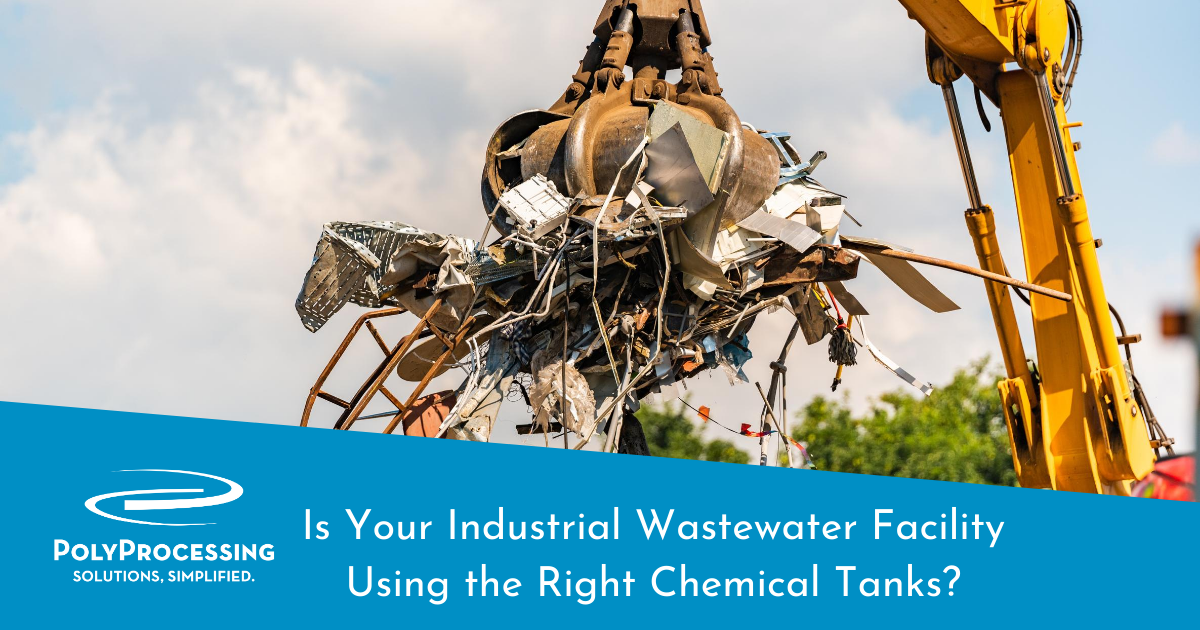Is Your Industrial Wastewater Facility Using the Right Chemical Tanks?
If your industrial company produces hazardous runoff from operating equipment, you need to treat the wastewater before dumping it into the sewer or wastewater stream. Depending on your industry, you may need to have a very detailed process that meets the highest standards. Each state and city might have their own standards and regulations you’ll need to meet, or you might be under federal regulations.

But your process is only as good as your chemical storage solution.
If your chemical tanks aren’t designed properly, you could be dealing with a dangerous system failure that shuts down your industrial wastewater treatment facility.
The Importance of Chemical Storage in Industrial Wastewater Treatment
Chemicals are essential in treating wastewater. In fact, wastewater treatment requires aggressive chemicals to treat the water. It’s always important to properly and safely store the chemicals that are used in the treatment process.
All too often, facility planners make late-game decisions about chemical storage solutions. As a result, they spec out a tank that’s designed to fit the space, rather than designing a tank for their particular needs and designing a space to accommodate the storage system’s requirements. The result is a less-than-ideal solution that negatively impacts the operations of the industrial wastewater treatment facility.
A chemical tank is one of the most important systems in industrial wastewater treatment, because if the tank fails, the entire treatment system could shut down.
Chemicals Used in Wastewater Treatment
Poly Processing has been in the industrial wastewater treatment business for over 50 years. We provide tank solutions for industries as diverse as:
- Power Generation
- Oil & Gas
- Chemical
- Food & Beverage
- Mining
- Automotive Salvage Yards and Scrap Yards
- Aerospace
- Textile
- Defense
Our cross-linked polyethylene (XLPE) tanks have earned a reputation for safely treating the most hazardous chemicals used in wastewater treatment. Poly tanks are storing chemicals like these:
- Coagulants and flocculants: aluminum sulfate, aluminum chloride, ferric chloride, ferric sulfate
- Disinfectants: sodium hypochlorite, chlorine dioxide, hydrogen peroxide
- pH adjusters and stabilizers: sodium hydroxide, sulfuric acid, magnesium hydroxide
- Oxidizers: peracetic acid, perchloric acid, chromic acid
Industrial Wastewater Treatment Processes
Let’s take a brief look at how these chemicals are used in the wastewater treatment process.
- Neutralization — Neutralization is common in wastewater treatment. During this process, sulfuric acid, or a basic chemical such as sodium hydroxide, may be added to the water to achieve pH balance.
- Removing solid particles — To facilitate the removal of solid particles within the wastewater, chemicals such as ferric chloride, alum, and other flocculants and polymers are used to produce positive charges to neutralize negative charged solid particles.
- Odor control — Unsurprisingly, the collection and treatment of industrial wastewater results in some unpleasant odors, and chemicals are used to control such odors at the treatment facility.
- Disinfection — To prevent the spread of disease, microorganisms that are pathogens must be destroyed or removed from the wastewater.
- Sludge treatment and removal — A polymer chemical may be used to remove water from the sludge to reduce volume, making transporting the sludge to the landfill easier and less expensive.
Reliable chemical storage depends on several factors — your industry, the size of your business, and federal, state and local regulations. Poly Processing Company can provide custom chemical storage solutions to fit your wastewater treatment needs.
The Right Storage Solution for Wastewater Chemicals
Industrial wastewater treatment chemicals require a strong, safe storage solution to combat their corrosive properties — but not all tanks are created equal.
Fiberglass
Fiberglass storage tanks are constructed of wound strips that overlap or a sprayed on fiberglass material, which means they can contain many seams. Each seam can be a weak point that provides another opportunity for a leak or tank failure. Fiberglass is also expensive, and the additional corrosion barriers for aggressive chemicals only raises the costs even more. If you purchase a fiberglass tank, be prepared for continual inspection and maintenance.
Linear Polyethylene
Because of the drawbacks of fiberglass tanks, many industrial treatment facilities use linear polyethylene tanks instead. But while linear polyethylene is less expensive than fiberglass, it’s less robust than cross-linked polyethylene and gives the end user less useful life.
Cross-linked Polyethylene
Cross-linked polyethylene tanks are cost-effective, resistant to aggressive chemicals, and very robust. Our tanks have a seamless one-piece molded construction, so there are no seams for leaks to develop.
Find out more about how we can make your facility more effective—download our wastewater chemical storage guide.
- August 3, 2020
- Topics: Chemicals, Tank Design and Materials, Chemical Storage
About Poly Processing
Posts By Topic
Tech Talk Podcast Episodes
Subscribe By Email
Recent Posts
- Installation Tips for Chemical Storage Tanks: Site Preparation and Offloading
- Understanding pH and Chemical Concentration When Choosing a Chemical Tank
- Maximizing Fill Efficiency: Selecting the Optimal Fill Line System
- Chemical Storage Tanks: A Quick Guide for End Users
- Popular Customization Options for Chemical Storage Tanks
Tank Configurator

Find the recommended tank and system components for your chemical storage challenge.
Configure a Tank Package




